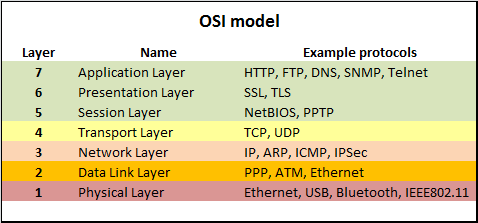- Layer 1 – Physical: The layer that responsible for the layout of cables and devices
- Layer 2 – Data Link: This is where the Media Access Control (MAC) addresses reside. The data link layer is used to transfer data between between nodes on a portion of a network to the physical layer.
- Layer 3 – Network: Do you want your packets routed? Well this is the layer where this data in the form of packets is routed across network segments.
- Layer 4 – Transport: The home of TCP/UDP. The transport layer ensures that the packets are transported reliably and without errors.
- Layer 5 – Session: The session layer is used to establish sessions between networked devices.
- Layer 6 – Presentation: Data translator for network devices.
- Layer 7 – Application: This is where the protocols that hosts use to communicate on a network live. Here’s some Application layer protocols that you would have heard of: Domain Name System (DNS), File Transfer Protocol (FTP), Simple Mail Transfer Protocol (SMTP), Server Message Block (SMB), Network File System (NFS) and Telnet.

The OSI model is more of a general networking model and it most definitely has it’s purpose, but it has largely been replaced by the TCP/IP model AKA the Internet protocol suite. The Internet protocol suite is comprised of 4 layers which include the following:
- Application layer – SNMP, HTTP/HTTPS, BGP, SMTP, NTP, SSH, Telnet, TLS/SSL, FTP, RDP, BitTorrent, Websocket
- Transport layer – TCP, UDP
- Internet Layer – IP (IPv4, IPv6), ICMP, IPsec
- Link Layer – ARP, Ethernet, WiFi, MAC, PPP